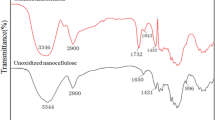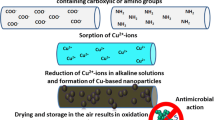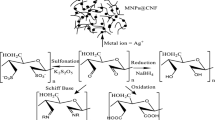Abstract
Hybrid inorganic–organic fillers based on nanostructured silver/zinc oxide decorations on micro-cellulose carrier particles were prepared by stepwise microwave assisted hydrothermal synthesis using soluble salts as precursors of silver and zinc oxide. Hexamethylenetetramine was used as precipitating agent for zinc oxide and reducing agent for silver. The inorganics covered all available surfaces of the cellulose particles with a morphology resembling a coral reef. Prepared particulate fillers were compounded to medical grade poly(vinyl chloride) matrix. Scanning electron microscopy and powder X-ray diffractometry were used to investigate the morphology and crystalline phase structure of fillers. The scanning electron microscopy was used for morphological study of composites. With respect to prospective application, the composites were tested on electrical and antibacterial properties. A small effect of water absorption in polymer composites on their dielectric properties was observed but no adverse effect of water exposure on prepared materials was manifested. Electrical conductivity of fillers and composites was measured and no influence of water soaking of composites was found at all. The surface antibacterial activity of prepared composites was evaluated according to the standard ISO 22196. Excellent performance against Escherichia coli and very high against Staphylococcus aureus was achieved.




Similar content being viewed by others
References
Vroman I, Tighzert L. Biodegradable polymers. Materials. 2009;2(2):307–44.
Sannino A, Demitri C, Madaghiele M. Biodegradable cellulose-based hydrogels: design and applications. Materials. 2009;2(2):353–73.
Sirolli V, Di Stante S, Stuard S, Di Liberato L, Amoroso L, Cappelli P, et al. Biocompatibility and functional performance of a polyethylene glycol acid-grafted cellulosic membrane for hemodialysis. Int J Artif Organs. 2000;23(6):356–64.
Kwon JW, Yoon SH, Lee SS, Seo KW, Shim IW. Preparation of silver nanoparticles in cellulose acetate polymer and the reaction chemistry of silver complexes in the polymer. Bull Korean Chem Soc. 2005;26(5):837–40.
Silva AR, Unali G. Controlled silver delivery by silver-cellulose nanocomposites prepared by a one-pot green synthesis assisted by microwaves. Nanotechnology. 2011;22(31):315605.
Siqueira G, Bras J, Dufresne A. Cellulosic bionanocomposites: a review of preparation, properties and applications. Polymers. 2010;2(4):728–65.
Stenstad P, Andresen M, Tanem BS, Stenius P. Chemical surface modifications of microfibrillated cellulose. Cellulose. 2008;15(1):35–45.
Goncalves G, Marques PAAP, Neto CP, Trindade T, Peres M, Monteiro T. Growth, structural, and optical characterization of ZnO-coated cellulosic fibers. Cryst Growth Des. 2009;9(1):386–90.
Singh AV, Rahman A, Kumar N, Aditi AS, Galluzzi M, Bovio S, et al. Bio-inspired approaches to design smart fabrics. Mater Des. 2012;36:829–39.
Wiesner MR, Lowry GV, Alvarez P, Dionysiou D, Biswas P. Assessing the risks of manufactured nanomaterials. Environ Sci Technol. 2006;40(14):4336–45.
Dastjerdi R, Montazer M. A review on the application of inorganic nano-structured materials in the modification of textiles: focus on anti-microbial properties. Colloids Surf B Biointerfaces. 2010;79(1):5–18.
Sastri VS. Plastics in medical devices: properties, requirements and applications. Norwich: Elsevier/William Andrew; 2010.
Cioffi N, Rai M. Nano-antimicrobials: progress and prospects. Berlin: Springer; 2012.
von Eiff C, Jansen B, Kohnen W, Becker K. Infections associated with medical devices—pathogenesis, management and prophylaxis. Drugs. 2005;65(2):179–214.
Morones JR, Elechiguerra JL, Camacho A, Holt K, Kouri JB, Ramirez JT, et al. The bactericidal effect of silver nanoparticles. Nanotechnology. 2005;16(10):2346–53.
Sedlarik V. Antimicrobial modifications of polymers. In: Chamy R, Rosenkranz F, editors. Biodegradation—life of science. Croatia: InTech; 2013.
Panacek A, Kvitek L, Prucek R, Kolar M, Vecerova R, Pizurova N, et al. Silver colloid nanoparticles: synthesis, characterization, and their antibacterial activity. J Phys Chem B. 2006;110(33):16248–53.
Yousef JM, Danial EN. In vitro antibacterial activity and minimum inhibitory concentration of zinc oxide and nano-particle zinc oxide against pathogenic strains. J Health Sci. 2012;2(4):38–42.
Li QL, Mahendra S, Lyon DY, Brunet L, Liga MV, Li D, et al. Antimicrobial nanomaterials for water disinfection and microbial control: potential applications and implications. Water Res. 2008;42(18):4591–602.
Yamamoto O, Nakakoshi K, Sasamoto T, Nakagawa H, Miura K. Adsorption and growth inhibition of bacteria on carbon materials containing zinc oxide. Carbon. 2001;39(11):1643–51.
Cao XL, Cheng C, Ma YL, Zhao CS. Preparation of silver nanoparticles with antimicrobial activities and the researches of their biocompatibilities. J Mater Sci Mater Med. 2010;21(10):2861–8.
Lu Z, Rong KF, Li J, Yang H, Chen R. Size-dependent antibacterial activities of silver nanoparticles against oral anaerobic pathogenic bacteria. J Mater Sci Mater Med. 2013;24(6):1465–71.
Ghosh S, Goudar VS, Padmalekha KG, Bhat SV, Indi SS, Vasan HN. ZnO/Ag nanohybrid: synthesis, characterization, synergistic antibacterial activity and its mechanism. RSC Adv. 2012;2(3):930–40.
Lu WW, Liu GS, Gao SY, Xing ST, Wang JJ. Tyrosine-assisted preparation of Ag/ZnO nanocomposites with enhanced photocatalytic performance and synergistic antibacterial activities. Nanotechnology. 2008;19(44):445711.
Shah AH, Manikandan E, Ahmed MB, Ganesan V. Enhanced bioactivity of Ag/ZnO nanorods-a comparative antibacterial study. J Nanomed Nanotechol. 2013;4(168):2.
Bazant P, Kuritka I, Hudecek O, Machovsky M, Mrlik M, Sedlacek T. Microwave-assisted synthesis of Ag/ZnO hybrid filler, preparation, and characterization of antibacterial poly(vinyl chloride) composites made from the same. Polym Compos. 2014;35(1):19–26.
Sachot N, Castano O, Mateos-Timoneda MA, Engel E, Planell JA. Hierarchically engineered fibrous scaffolds for bone regeneration. J R Soc Interface. 2013;10(88):20130684.
ISO 22196:2007 (E). Plastics—measurement of antimicrobial activity on plastics surfaces. Geneva, Switzerland: International standard, International Organization for Standardization; 2007.
Jones A. Killer plastics: antimicrobial additives for polymers. Plast Eng. 2008;64(8):34–40.
JIS Z 2801. Antimicrobial products—test for antimicrobial activity and efficacy. Tokyo, Japan: Japanese Standards Association, JIS Z 2801; 2000.
Torlak E, Sert D. Antibacterial effectiveness of chitosane-propolis coated polypropylene films against foodborne pathogens. Int J Biol Macromol. 2013;60:52–5.
Bazant P, Kuritka I, Machovsky M, Sedlacek T, Pastorek M, editors. Microwave assisted synthesis of Ag–ZnO particles and their antibacterial properties. Mathematical methods and techniques in engineering and environmental science 4th WSEAS international conferences on material science; 3–5.11.2011; Catania, Italy; 2011.
Baruah S, Dutta J. Hydrothermal growth of ZnO nanostructures. Sci Technol Adv Mater. 2009;10(1):013001.
Chazeau L, Cavaille JY, Canova G, Dendievel R, Boutherin B. Viscoelastic properties of plasticized PVC reinforced with cellulose whiskers. J Appl Polym Sci. 1999;71(11):1797–808.
Cassie ABD, Baxter S. Wettability of porous surfaces. Trans Faraday Soc. 1944;40:546–51.
Wenzel R. Resistance of solid surfaces to wetting by water. Ind Eng Chem. 1936;28(8):988–94.
Extrand CW. Criteria for ultralyophobic surfaces. Langmuir. 2004;20(12):5013–8.
Rush S, Mcfee R, Abildskov JA. Resistivity of body tissues at low frequencies. Circ Res. 1963;12(1):40–50.
Latif I, Al-Abodi EE, Badri DH, Khafari JA. Preparation, characterization and electrical study of (carboxymethylated polyvinyl alcohol/ZnO) nanocomposites. Am J Polym Sci. 2012;2(6):135–40.
Jasem SH, Hussain WA. Dielectric properties of carbon black/PVC (cement) composites. J Appl Polym Sci. 2012;38(1.A):60–70.
Geilich BM, Webster TJ. Reduced adhesion of Staphylococcus aureus to ZnO/PVC nanocomposites. Int J Nanomed. 2013;8:1177–84.
Marambio-Jones C, Hoek EMV. A review of the antibacterial effects of silver nanomaterials and potential implications for human health and the environment. J Nanopart Res. 2010;12(5):1531–51.
Kong H, Jang J. Antibacterial properties of novel poly(methyl methacrylate) nanofiber containing silver nanoparticles. Langmuir. 2008;24(5):2051–6.
Nair S, Sasidharan A, Rani VVD, Menon D, Nair S, Manzoor K, et al. Role of size scale of ZnO nanoparticles and microparticles on toxicity toward bacteria and osteoblast cancer cells. J Mater Sci Mater Med. 2009;20:235–41.
Spathis P, Poulios I. The corrosion and photocorrosion of zinc and zinc-oxide coatings. Corros Sci. 1995;37(5):673–80.
Yang ZM, Zhang P, Ding YH, Jiang Y, Long ZL, Dai WL. Facile synthesis of Ag/ZnO heterostructures assisted by UV irradiation: highly photocatalytic property and enhanced photostability. Mater Res Bull. 2011;46(10):1625–31.
Acknowledgments
This article was written with support of Operational Program Research and Development for Innovations co-funded by the European Regional Development Fund (ERDF) and national budget of Czech Republic, within the framework of project Centre of Polymer Systems (reg. number: CZ.1.05/2.1.00/03.0111). The authors also acknowledge the support of Operational Program Education for Competitiveness co-funded by the European Social Fund (ESF) and national budget of Czech Republic, within the framework of project Advanced Theoretical and Experimental Studies of Polymer Systems (reg. number: CZ.1.07/2.3.00/20.0104). The work of L. M. was supported by the Internal Grant Agency of Tomas Bata University in Zlin; contract Grant Number: IGA/FT/2014/008.
Author information
Authors and Affiliations
Corresponding author
Electronic supplementary material
Below is the link to the electronic supplementary material.
Rights and permissions
About this article
Cite this article
Bazant, P., Kuritka, I., Munster, L. et al. Hybrid nanostructured Ag/ZnO decorated powder cellulose fillers for medical plastics with enhanced surface antibacterial activity. J Mater Sci: Mater Med 25, 2501–2512 (2014). https://doi.org/10.1007/s10856-014-5274-5
Received:
Accepted:
Published:
Issue Date:
DOI: https://doi.org/10.1007/s10856-014-5274-5




